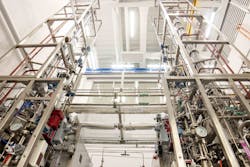Latest from Hydronics
Sponsored
BATON ROUGE, LA — (GLOBE NEWSWIRE) -- The LSU Cain Department of Chemical Engineering recently completed a journey of several years with the installation of its new distillation columns. The towering structure consumes two floors of Patrick F. Taylor Hall and offers students the opportunity to work on a true commercial analog of the same equipment they will be expected to operate when they enter the workforce as chemical engineers.
The Science
Many of the precursors for common products come through distillation columns—plastic packaging, backpacks, detergents, refrigerants, even the precursors to make LED lights, to name a few examples. This is because chemical reactions typically produce more than one product, which then needs to be separated or purified, and distillation is the most common separation process.
Broadly speaking, the unit—which is located in the Dow Unit Operations Laboratory in Patrick F. Taylor Hall—separates components, water and a series of glycols, into pure or near pure components by the differences in their vapor pressure. For example, if a mixture of 50 percent water and 50 percent glycol are fed into the unit, a stream of “very nearly” pure water is produced from the top of the tower and pure glycol from the bottom. This is accomplished by heating and vaporizing the material in the bottom of the tower and returning a portion of it back down the tower after it is cooled and condensed.
The Technology
“This unit would not be out of place at a commercial pharmaceutical or specialty chemical facility that operates in the commercial world,” said John Pendergast, professional-in-residence in the Cain Department of Chemical Engineering. “It is built to those specifications and design criteria. Very few students will have the ability to learn on, operate, and study the response of a facility [like the one we have here] that is very close to the unit operation of distillation that dominates the separation landscape of our industry.
"We have a Reimers boiler unit from Electra Steam, Inc. The model is RX100, meaning the heating power is 100KW delivering 10 boiler horsepower (334,790 Btu per hour). The unit can operate on 220/480-volt (nominal) power. Steam is delivered up to ~5.9 bar pressure," Pendergast said.
The boiler had been installed in the laboratory as part of general preparation for the lab, with the plan of having the distillation unit set in place in a dedicated area. "Of course, the size and capability of the distillation depends on how much steam we can provide to the unit, so [the boiler] was / is an integral part of the entire project," Pendergast said.
Years of Expertise
Pendergast, who joined the college in 2018 following a 40-plus-year career at Dow Chemical, was the main designer of the distillation columns and put his years of expertise at Dow into this project. He previously served the company as project manager or lead process engineer on several world-scale processes and plants, and most of his career involved research into separation methods and the implementation of advanced separations that reduce energy consumption or capital consumption or both.
“The primary design criterion for the unit was/is the safety of the students and the inhabitants of PFT,” Pendergast said. “The advanced features of this unit are that it can be used independently by two undergraduate groups at the same time, running realistic distillation experiments that would be seen in industry.
“In addition to that, this unit can be combined to advanced distillation sequences that are more energy efficient. The units can be used for research to study methods that improve our understanding of these advanced sequences and enable a better understanding and adoption of distillation methods that can reduce energy consumption in our industry.”
The columns were fabricated overseas by the French company Pignat, which builds educational equipment, as well as larger-scale equipment for companies like L’Oreal and Michelin. They were originally scheduled to arrive at PFT for assembly in April of this year; however, the COVID-19 pandemic contributed to delays during different stages of the process. In the end, Pignat representatives Regis Rodriguez and Mathias Fragola, along with the company’s U.S. representative Harold Sheppard, were able to make their way to campus and begin final work on the unit.
“Working with an international team has its challenges, especially during COVID,” said Thomas Schroeder, who oversees the operation of the columns as research specialist in the Dow Unit Operations Laboratory. “Shipping equipment to them (i.e, computers, sensors, etc.) was especially difficult, as the lockdowns [began] as we were trying to get them the equipment we purchased for the project. We had to do the [Factory Acceptance Test] over Zoom instead of in person, due to travel restrictions. That said, we maintained communication and made sure the columns were made to our specifications.”
Future Plans
Going forward, Pendergast said the plan for the unit is to utilize the equipment in undergraduate labs this fall; develop projects that can support undergraduate and graduate research work; and seek partners from industry, as well as other sources, to gather funding for graduate research that will support research and publications that advance students at the undergraduate and graduate level.
The distillation columns were made possible, in part, by the Bert S. Turner Endowment for Excellence in Engineering Education, Valero, and other donors and individuals.



